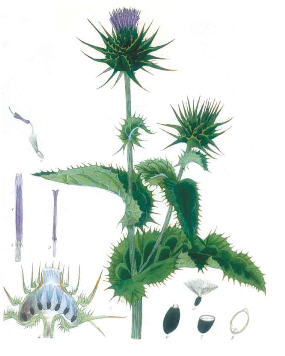Milk Thistle, Mary Thistle

Milk thistle probably originated in the Mediterranean region, and is naturalized in much of Europe, North America, South America, and Australia, growing in abandoned fields, old pastures, and by roadsides. Ti has been cultivated for centuries.
The plant should not be confused with holy thistle (Cnicus benedictus). Milk thistle can grow to a height of 1.5 m (5 ft) and is an annual or biennial. The leaves have distinctive white markings with spines on the lobes. Its large flower head, surrounded by bracts, consists of purple florets.
The “seeds” (botanically speaking, the fruits) are the source of herbal medicine. The plant has been utilized as a vegetable and salad item, and the flower receptacle has been used like globe artichoke.
For hundreds, and maybe thousands, of years it has been used to treat liver disease and damage, including cirrhosis, hepatitis, jaundice, effects of chemotherapy, and poisoning by carbon tetrachloride or amanita mushrooms.
A complex known as silymarin (1-4% of which is composed of flaonolignans) is found in the “seeds”. In Germany, where there has been considerable interest in the drug, it is recommended as a supportive treatment for inflammatory liver conditions and cirrhosis. For various reasons, it is best given by injection.

